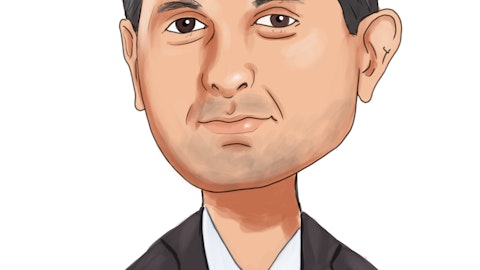Dr. Harlan Weisman : Yes. Thank you for the question. Just to clarify, it’s enough cash to get us through the first quarter of next year. And clearly, we are going to have to raise money again based on the expected inflection point from us producing data, we think it will be a catalyst to allow us to raise more money. The first order of business when we raise money is to be able to continue to fund the development of TFF VORI and TFF TAC. So, I want to ensure that we don’t drop the ball on those two programs and get too unfocused. So, that’s our initial focus. But, as you pointed out, there are other molecules. And we have a process underway to evaluate potential pipeline products. We recently reacquired full rights in the niclosamide.
I’m not saying we would go forward with that, but it’s — we have it and we are currently evaluating whether it makes sense to go forward with niclosamide and indications besides COVID-19, which was the original idea of it, and we’ll evaluate that. But we’re also — have shown that our technology is able to take, for example, a large variety of biologics, like monoclonal antibodies, vaccines, and we have the agreement with NIH to develop a universal flu vaccine and mRNAs and even bacterial causes. And so there’s — we have a wealth of different opportunities. The key is going to be to see what we should focus on. And it’s premature for me to say that with any degree of certainty. We really have to go through that evaluation process, which we will get underway and we have underway right now.
Operator: The last question comes from Daniel Carlson at Tailwinds.
Daniel Carlson: Question — just a couple of follow-up questions. Regarding the Expanded Access Program, is that data that something you can submit to the regulatory authorities, like the FDA or EMA and will they consider that data when advising on potential next steps?
Dr. Harlan Weisman: Yes. Dan, first of all good morning, and thank you for participating. I appreciate the question. We believe the answer is yes, but let me let Zamaneh elaborate.
Dr. Zamaneh Mikhak: Hi, Dan. Yes. Yes, we believe that will be part of the data package. The expanded access data, after all is valuable and helpful data that what TFF VORI has been able to do. And the FDA does accept that as part of the data or package that one submits.
Daniel Carlson: Great. Zamaneh, you mentioned for the Phase 2 VORI, expanding the eligibility criteria with additional real world criteria. Can you just elaborate on what that means exactly?
Dr. Zamaneh Mikhak: Sure. So, with every clinical trial, obviously, you need to make sure that you get the right patients because, for example, if the patient doesn’t have, let’s say aspergillus, which responds to voriconazole, then obviously one couldn’t expect TFF VORI to cause improvement. So, it’s important to make sure you get the right patients in. The diagnostic criteria, that’s part of the protocol that is customarily part of the protocol for IPA type studies is a very strict and academic type of diagnostic criteria, which is very valuable, but it is very strict. For example, it includes that the patients have to have certain signs and symptoms to be part of that, to be eligible as part of meeting the criteria.
And those signs and symptoms don’t include worsening cough. Now, in reality, when physicians face, for example, we’re talking about the patient with hematologic malignancy, you have that patient with AML, who’s now developed a fungal, pulmonary fungal infection. They see that the patient has increased respiratory symptoms, including a productive cough that has worsened and the chest CT shows a cavity and they grow aspergillus from their lungs. That patient in the real world gets treated with voriconazole for their probable diagnosis of IPA. But based on that academic set of criteria, that patient wouldn’t be considered because worsening cough is not one of the specific signs and symptoms mentioned in that diagnostic criteria. So, after talking with our investigators, one of the — they gave us feedback about various aspects, and one of the pieces of feedback we received was this, that, in the real world, we actually diagnose patients with IPA, bringing clinical judgment and putting the various parameters together to get a story, get a picture of does this fit IPA or not.


